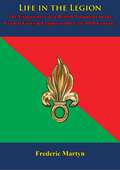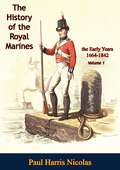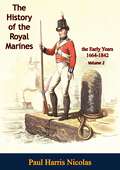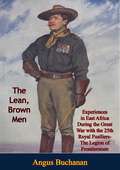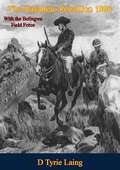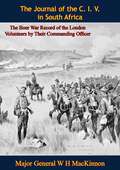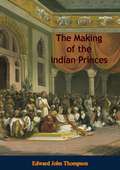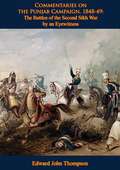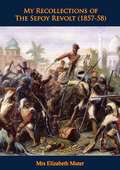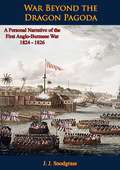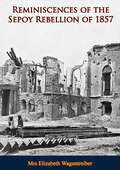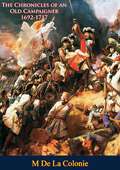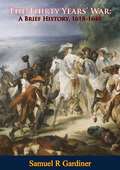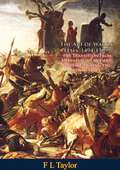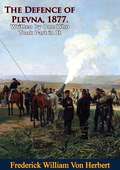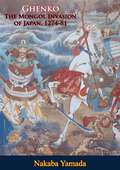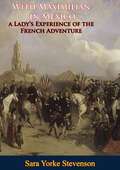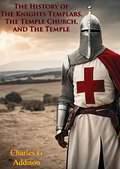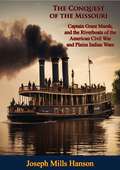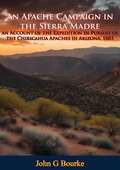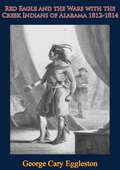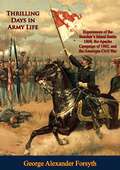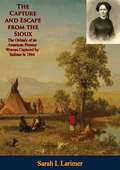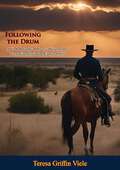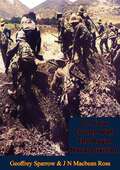- Table View
- List View
Life in the Legion: The Experiences of a British Volunteer in the French Foreign Legion in the Late 19th Century
by Frederic MartynOn campaign under the tricolor“This is an essential book for all those interested in the French Foreign Legion because it is a brilliant first hand account written by an English 'gentleman volunteer' who experienced 'life in the legion' in the late 1880's and who had previously been a serving officer in one of the cavalry regiments of the British Army. Far from being a tale of hardship and abuse, the author had nothing but admiration for the Legion and—as an experienced soldier—obviously thoroughly enjoyed the five years he spent serving in its ranks. The writer quite simply could not have enough action and he volunteered to serve in Tonkin, Dahomey and against the Tuareg tribesmen of North Africa. In consequence this book is full of colourful and detailed campaign and battle action which is compellingly recounted by a fighting soldier more than capable of putting his engrossing story into words. Highly recommended.”-Print ed.
The History of the Royal Marines: The Early Years 1664-1842: Volume 1 (The History of the Royal Marines: the Early Years 1664-1842 #1)
by Paul Harris Nicolas“The first volume of a two volume anniversary history of the early Royal Marines.The Royal Marines can trace their origins back to the formation of 'The Duke of York and Albany's Maritime Regiment of Foot' in 1664…The Royal Marines as we know them today were formed in 1755 and since that time they have distinguished themselves in many conflicts fought by the British to the present day. Numerous books have been written about the exploits of the Royal Marines, particularly in the 20th century, but this special two volume edition concentrates on the earliest period of their history. The presence of red-coated marines was inseparable from the blue uniform of their naval comrades during the great age of sail and this book covers that period in detail including the American War of Independence. The great contest of the early 19th century was against Revolutionary, Consulate and Napoleon Bonaparte's First Empire of the French. The Royal Marines fought in every major naval engagement of that long war, all of which are detailed in these pages together with many minor engagements, the War of 1812 and the imperial campaigns including the Chinese Opium Wars.”-Print ed.
The History of the Royal Marines: The Early Years 1664-1842: Volume 2 (The History of the Royal Marines: the Early Years 1664-1842 #2)
by Paul Harris Nicolas“The first volume of a two volume anniversary history of the early Royal Marines.The Royal Marines can trace their origins back to the formation of 'The Duke of York and Albany's Maritime Regiment of Foot' in 1664…The Royal Marines as we know them today were formed in 1755 and since that time they have distinguished themselves in many conflicts fought by the British to the present day. Numerous books have been written about the exploits of the Royal Marines, particularly in the 20th century, but this special two volume edition concentrates on the earliest period of their history. The presence of red-coated marines was inseparable from the blue uniform of their naval comrades during the great age of sail and this book covers that period in detail including the American War of Independence. The great contest of the early 19th century was against Revolutionary, Consulate and Napoleon Bonaparte's First Empire of the French. The Royal Marines fought in every major naval engagement of that long war, all of which are detailed in these pages together with many minor engagements, the War of 1812 and the imperial campaigns including the Chinese Opium Wars.”-Print ed.
The Lean, Brown Men: with the 25th Royal Fusiliers-The Legion of Frontiersmen
by Angus Buchanan“Lean men, brown men, men from overseas,Men from all the outer world; shy and ill at easeThere were Canadian Mounties, American cowboys, Arctic explorers, adventurers, rogues, big game hunters and sportsmen. There were famous men like Cherry Kearton, the naturalist and explorer and the grand old man of Africa—Frederick Selous himself. All these men had come together under the Union Flag to do battle against colonial Imperial Germany in East Africa. They came under the command of Driscoll of Driscoll's Scouts who performed with renown during the Boer War. These were the men of the 25th Royal Fusiliers—The Legion of Frontiersmen—and their battlegrounds were to be the great plains of Africa rich in wildlife and elemental danger. This is their story through the years of the Great War told by one of their own officers in vivid detail. It is a story of campaigns and hardship which would be equal to the best of them and lay many a 'lean, brown man' in a shallow grave in the red earth before it was concluded.”-Print ed.
The Matabele Rebellion 1896 With the Belingwe Field Force: With The Belingwe Field Force (classic Reprint)
by D Tyrie Laing“The struggles for AfricaThere can be few more interesting and evocative periods of British imperial history than the struggles for south-eastern Africa. The empire had found itself colliding with the interests of many native powers across the globe during the decades of its expansion. Many had fought to maintain their independence and some, like the Sikhs of the Punjab, were sufficiently well versed in the practice of warfare as to be a serious threat. This could not be said of the tribes which rose from the Zulu nation, yet the Zulu War of 1879 gave British forces a chilling and brutal lesson in what a 'primitive' African tribal army was capable of achieving on the field of battle. The Matabele, as an off-shoot of the martial Zulus, also inevitably came into conflict with the British during the closing decade of the 19th century. The First Matabele War did not decisively subjugate the tribe and in 1896 it rose again laying siege to Bulawayo with over 10,000 Ndebele warriors.”-Print ed.
The Journal of the C. I. V. in South Africa: The Boer War Record of the London Volunteers by Their Commanding Officer
by Major General W H MacKinnon“London men at war against the BoersThe turn of the 19th century to 20th was a time of popularity for the military volunteer movement in the British Empire. When the Anglo-Boer War broke out the City Imperial Volunteers quickly filled its ranks with the men of the City of London anxious to serve their country in South Africa. The venture was supported by the Lord Mayor and the popularity of London's effort had widespread appeal. All manner of men hurried to join the C. I. V's ranks and many of them were professionals from the city's law firms and financial institutions, artists, writers or gentlemen of private means. The author of The Riddle of the Sands, Erskine Childers was one of their number. This book is comprised of the journal entries of the officer commanding the regiment and it follows the C. I. V's wartime experiences from recruitment to its return home. The C. I. V was well regarded on campaign and earned the praise of peers and senior officers alike. This book delivers its information in the sober manner one might expect of its author in the circumstances, but is nevertheless essential source material about each part of the unit-the infantry, mounted infantry, cyclists, medical staff etc. Included as an appendix is a substantial honour role that will be of special interest to genealogists.”-Print ed.
The Making of the Indian Princes
by Edward John ThompsonIndia’s political framework was made in twenty years: in 1799-1819, between the death of Tipu Sultan and the elimination of the Peshwa. The period opens with the destruction of the Muslim kingdom of Mysore and ends with the disintegration of the Maratha Confederacy into a series of separate chieftaincies. These two conquests gave the British the control of India.After Tipu’s destruction the Marathas remained. When they were finally beaten down, Modern India was formed and its map in essentials drawn. The arrangement was to stay until the slow process of time and the coming of new systems of political thinking made it an anachronism, calling for Round Table Conferences, White Papers, and their sequel in constitutional legislation and political offers. India, as we knew it yesterday and the world has known it, was made in the space of these twenty years, first by the shattering of what Lord Wellesley styled ‘the Mahratta Empire’ and then, after a brief period of uncertain and faltering doctrine, by Lord Hastings’ firm establishment of the States which had survived, each in the niche and status which was to be legally accepted as its own until our day. The Indian ‘Prince’ emerged in 1806, arising, like the Puranic Urvasi, from the churning of the Ocean by the Gods and Demons, and received his position in India’s polity in 1819.
Commentaries on the Punjab Campaign, 1848-49: the Battles of the Second Sikh War by an Eyewitness
by James Henry Lawrence-Archer“An infantry officer's view of the fall of the Sikhs.The author of this book served with No 6 company of HM 24th Regiment-an infantry regiment of the British Army-which saw much service in the Second Sikh War and suffered greatly in the fighting particularly at Chillianwalla. So there could hardly be a more qualified writer—or one with closer connections to other participants—to take on the task of reporting the war. At the conclusion of the First Sikh War there remained a sense of business unfinished. The Sikhs were yet masters of the Punjab and the Khalsa remained one of the most formidable armies the Sub-Continent had ever seen. Most importantly the centre of Sikh power, the seemingly impregnable and daunting fortress of Mooltan remained defiant. Once again the British Empire learnt the lesson of what a formidable foe the Sikhs were as they joined battle with them at Ramnuggar, Chillianwalla, Mooltan and Googerat. Archer takes us through this campaign in compelling detail embellished by an insight only first hand experience can provide.”-Print ed.
My Recollections of The Sepoy Revolt (1857-58)
by Mrs Elizabeth Muter“Mrs Elizabeth McMullin Muter was married to a captain of the 1st Battalion 60th King's Royal Rifles stationed in Meerut, a few hours travel east of Delhi, when the mutiny among the sepoys of the garrison broke out there on Sunday morning of May 10th, 1857. Elizabeth Muter graphically describes the horrors of those first days of the conflict from the perspective of the wives of officers who were set adrift in times of peril and uncertainty as their husbands left them to fight. This book also contains some campaign recollections by Captain Muter.”-Print ed.
War Beyond the Dragon Pagoda: A Personal Narrative of the First Anglo-Burmese War 1824 - 1826
by J. J. Snodgrass“The author—a staff officer—who was an eyewitness to most of the major events of the First Anglo-Burmese War, gives us an incisive overview of the whole war. This provides the reader with a unique insight into the actions of the various troops during the course of the campaign. However it is the author's descriptions of pitched battles against a richly caparisoned foe—including everything from umbrella bearing generals and war elephants to "invincibles" and Amazons—that bring this exotic and spectacular conflict vividly to life. Re-living this war from just one step away, whether witnessing fighting in jungle stockades or experiencing river actions against Burmese war boats, will remain with and intrigue all who are interested in the British in the East.”-Print ed.
Reminiscences of the Sepoy Rebellion of 1857
by Mrs Elizabeth Wagentreiber“Elizabeth Wagentreiber was the youngest daughter of Colonel James Skinner of the famous cavalry regiment 'Skinner's Horse'. She had originally married a Captain Radclyffe Haldane, an officer of Skinner's Horse who was killed at the Battle of Chillianwallah during the Second Anglo-Sikh War. She subsequently married George Wagentreiber. And in the Spring of 1857 the couple were living in the civilian lines at Delhi when the Indian Mutiny broke out in the Bengal Army and reports arrived that the native cavalry was running amok in the city, slaughtering Europeans. Fearful for their lives the couple escaped with their children and the harrowing account of their time as fugitives makes compelling reading.”-Print ed.
The Chronicles of an Old Campaigner 1692-1717: The Recollections of a French Dragoon Officer During the War of Spanish Succession
by M De La Colonie“An essential first hand account from a French soldier.Personal accounts by French soldiers have not proliferated in the English language and those that concern the Napoleonic Wars are much sought after by readers and invariably repay the effort to find them with an interesting tale, compellingly told. This account concerns another period some one hundred years or so before the time of the First Empire, but it too is a first rate personal account full of anecdote, drama, duelling, camp and campaign life, battles and sieges that will not disappoint. This highly regarded French soldier fought in the War of the Spanish Succession-among others-and so the reader will understand what warfare was like on the other side of the lines from the great Duke of Marlborough and his ally, Eugene of Savoy. Seconded to service by the Elector of Bavaria, the author was a committed and aggressive soldier who, together with his French contingent, invariably found himself in the thick of the action. This is an essential and riveting narrative from the time when central Europe was boiling with dispute and the Bourbon monarchy was at the pinnacle of its power and influence. Highly recommended.”-Print ed.
The Thirty Years' War: A Brief History, 1618-1648
by Samuel R Gardiner“A concise history of a cataclysmic European conflict in the 17th centuryThe Thirty Years' War was fought between 1618-1648 and is widely recognised as being one of the most destructive wars ever fought. More people lost their lives in this conflict, as a percentage of the total population at the time, than in the conflicts of the twentieth century. Fought principally in central Europe—and mostly over terrain now in modern day Germany—the war involved more than fifteen nation states. Forces were divided broadly on religious grounds, between Protestants and their allies and the Catholics of the Holy Roman Empire and Spain but also with elements of the Ottoman Turkish Empire. Self evidently this was a long, bloody conflict the causes of which were many and complex. Dynasties were born in its tumult, great men were brought to the fore and some, like Gustavus Adolphus of Sweden, would perish before its conclusion. The campaigns and battles of the Thirty Years' War have inspired historians across the centuries to the present day to write about them and many highly regarded works concerning the war have been published. This concise book takes a different approach; it sets out to give an understanding of the events and personalities involved and is an ideal overview for both specialists and those new to the subject.” – Print ed.
The Art of War in Italy, 1494-1529: the Transition From Mediaeval to Modern Warfare During the Renaissance
by F L Taylor“The birth of 'New War' in ItalyIt is easy to consider the Renaissance as a time of enlightenment typified principally by the artistic and scientific genius of Leonardo da Vinci and his peers; but giant leaps forward are never confined to one aspect of society and the application of new ideas is always adapted to various purposes and the meeting of differing objectives. The creation of modern political science by Niccolo Machiavelli is a prime example of how new ways of thinking and doing impacted on the advancement and securing of power. These changes were inevitably accompanied by significant developments in making war more effectively, strategically and tactically-with corresponding advances in weaponry and other equipage. This excellent book considers these developments through the changes to traditional military strategy and the use of infantry, cavalry and artillery, in both open battle and fortification and siege-craft, at the turn of the sixteenth century.”-Print ed.
The Defence of Plevna, 1877. Written by One Who Took Part in It
by Frederick William Von HerbertIn "The Defence of Plevna, 1877," readers are transported to the heart of one of the most pivotal moments in European history. Set against the backdrop of the Russo-Turkish War of 1877-1878, this gripping narrative chronicles the epic struggle for the Bulgarian town of Plevna.As the Russian Empire seeks to expand its influence in the Balkans and challenge Ottoman dominance, the small garrison town of Plevna becomes the focal point of a fierce and relentless battle. Led by the indomitable Ottoman commander, Osman Pasha, the defenders of Plevna are faced with overwhelming odds as they confront the might of the Russian army.Against the backdrop of political intrigue, military strategy, and personal drama, the fate of Plevna hangs in the balance. Will Osman Pasha and his valiant defenders withstand the onslaught of the Russian forces, or will the town fall, signaling a turning point in the course of history?"The Defence of Plevna, 1877" is not just a tale of warfare, but a testament to the human spirit in the face of adversity. It is a story of courage, honor, and the enduring struggle for freedom and independence. This book is essential reading for anyone interested in military history, the Balkans, or the complex dynamics of 19th-century Europe.
Ghenko: The Mongol Invasion of Japan, 1274-81
by Nakaba Yamada“A ferocious conflict between Mongol and Samurai.The Japanese word 'Ghenko' is the term employed for the Mongol invasion of Japan. The event was an immensely significant one for the Japanese and it remained so for centuries because, in part, the defeat of the invaders was attributed to divine intervention. There can be little doubt that Japan's salvation had much to do with the fact that they are an island race and in that they have much in common with other islanders, Great Britain among them, who on more than one occasion might claim the sea as their principal and most powerful ally. Indeed, the author of this book draws parallels with Britain and the Spanish Armada. The Mongols had rapidly risen to power during the 13th century and had created an unstoppable empire that spread over huge areas of land from the Yellow Sea of Asia to the Danube in Europe. Although massively stronger than the Japanese, the Mongols attacked the Japanese islands, attempting domination by invasion and yet were repulsed with finality. To modern students of military history the contents of this book has a compelling allure, since there can be no doubt that in the Mongol warrior and the Japanese Samurai there resided a martial spirit and expertise which, perhaps inevitably, could not both exist in the same sphere, but which in collision could not fail to instigate conflict of the most singular kind. This account of the clash between the ultimate warriors of their day analyses this time of warfare in superb detail. An essential addition to the library of anyone interested in the warfare of the East.”-Print ed.
With Maximilian in Mexico: a Lady's Experience of the French Adventure
by Sara Yorke Stevenson“A remarkable experience of little reported events.The Second Empire of France was, by the early 1860's in good health. France had acquitted itself well in the Crimea and in the war against Austria. The idea of a European monarch on the throne of Mexico was not a new one. France was attracted to the idea of a 'Latin' influence in America and thus the opening chords were struck of what would eventually be—to quote the author—'A Dance of Doom', the steps of which would lead the Archduke Maximilian to a stark wall there to be riddled with bullets from a Mexican firing squad. The author of this account—a young American woman living in Paris—was swept up in these extraordinary events and found herself in Mexico amongst its most influential figures. This is her essential and riveting story of turmoil and rebellion.”- Print ed.
The History of The Knights Templars, The Temple Church, and The Temple: Large Print
by Charles G Addison“The warrior knights of the crossThe Knights Templar were one of the most famous Christian military orders of the medieval period. Officially endorsed by the church in the early decades of the 12th century the express purpose of the order was to provide defence and protection to Christian pilgrims. The concept became a popular one and with patronage came wealth and power so that the order, through a substantial infrastructure of non-warrior members spread throughout Europe promoting its objectives, developing financial institutions and building fortification on a grand scale. However, the Knights Templar are especially remembered today for the prowess of their military knights. Clad in white mantles bearing the distinctive red cross the Templars both attracted and created some of the most expert and effective fighting men of their time. Naturally, the order was closely connected to the Holy Land and with the Crusades. For some two hundred years it fought the forces of Islam for dominance of Jerusalem experiencing mixed fortunes in dozens of actions and major battles. The eventual loss of the Holy Land could do no other than promote a decline in their fortunes, and indeed, the support for the Templars. Furthermore, the order's wealth and its independent structure, wielding power outside state and church, inevitably made it a target for both suspicion and dissolution. The end came in 1312—in a welter of torture, bloodshed and burnings at the stake. The legend has lived on however, and today the times of Knights Templar are to many more intriguing and evocative than ever.”-Print ed.
The Conquest of the Missouri: Captain Grant Marsh, and the Riverboats of the American Civil War and Plains Indian Wars
by Joseph Mills Hanson“A great river and those who sailed it.This well known and highly regarded classic of the opening up of the American West concentrates on the great rivers of North America and the Missouri in particular. Focus is, of course, placed to the iconic paddle-steamers, their captains and crews, that plied its waters and that have become emblematic of river navigation in 19th century America. The scope of the narrative is significant. Events are described from the mid-1850s and through the American Civil War. However, the book principally deals with the post Civil war period of westward expansion and the role of the vessels and the river itself in the wars against the plains Indians. The transportation of troops and materials played a significant part in these campaigns and this is, of course, is recounted here in some detail. Readers will learn about the exploits of boats including the 'Far West, ' 'Key West, ' Rosebud, ' 'Luella' and 'North Alabama' in this fascinating account of the American frontier afloat.”-Print ed.
An Apache Campaign in the Sierra Madre: an Account of the Expedition in Pursuit of the Chiricahua Apaches in Arizona, 1883
by John G Bourke“With Crook in pursuit of Geronimo and his band.The author of this book was a U.S. soldier in addition to being a well known and highly regarded author on the Apache Wars of the later nineteenth century-in which he was an active participant. He maintained an interest, respect for and in some measure an affection for the Apaches and he also made a serious study of and wrote notable works on their customs and culture. He is perhaps best known for his classic account of the Apache Wars, 'On the Border with Crook.' This small account was written prior to his larger and more expansive work. It originally appeared as a series of articles in the Boston published 'Outing Magazine.' Bourke decided to bring his earlier writings back into print in book form, at a time when the Apaches had once again taken the war trail, to provide the American public with context to then current events. This fascinating account, which centres on the events of the Spring of 1883, concerns Crook's pursuit of the Chiricahua Apaches who broke out of San Carlos reservation to raid through Arizona and Mexico before vanishing into the fastness of the Sierra Madre. Those with any interest or knowledge in this subject will find themselves familiarly introduced to the corps of Apache Scouts, Al Sieber (Zieber), the scout and interpreter, Crook, Gatewood, Chato and of course the renowned Geronimo, as well as other names long associated with this remarkable time in the history of the Apaches and Arizona.”-Print ed.
Red Eagle and the Wars with the Creek Indians of Alabama 1812-1814
by George Cary Eggleston“Red Sticks, White Sticks and the war in AlabamaThe Creek Indian War, also known as the Red Stick War, took place between 1813-1814 and has been considered by many historians as part of the War of 1812. The Creek—or Muscogee—Indians of Alabama were effectively waging a civil war among themselves. One militant faction, the so called Red Sticks, proposed an aggressive return to the traditional life of their forebears and an end to treaties with and concessions to pioneer settlers represented by the United States government. The White Sticks, opting for peace, inevitably took the opposing view. Although the conflict began as one between the indigenous Indians, American forces, under the soon to be famous Andrew Jackson among others, were drawn into the conflict because much of the animosity was focussed on pioneer settlements. The conflict started in the usual manner of American Indian Wars—with the murder of settler families. The inevitable revenge and retribution that followed—and an escalation of the kind of merciless savagery the Americans had come to expect—culminated in the massacre of 500 settlers, friendly Indians, mixed blood Creeks and soldiers at Fort Mims in an attack led by the Red Stick war leader, Red Eagle. Other forts were also attacked. Panic spread through the region exacerbated by the inability of the Federal government to provide ready aid since it was engaged against the British and their Indian allies to the east. As a consequence much of the fighting was undertaken by militias from Tennessee, Georgia and Mississippi supported by White Stick allies. National hero, Davy Crockett, also served in this conflict. The war ended in a victory for the Americans and put Andrew Jackson on a path to the presidency and the White House. It was a disaster for the entire Creek Indian tribe—irrespective of their allegiances—who paid for the conflict through the confiscation of vast tracts of their traditional lands.”-Print ed.
Thrilling Days in Army Life: Experiences of the Beecher's Island Battle 1868, the Apache Campaign of 1882, and the American Civil War
by George Alexander Forsyth“A highly regarded memoir of the Indian and Civil Wars.The author of this book, George A. (Sandy) Forsyth was a career soldier who served with distinction in the American Civil War and subsequently upon the western frontier against the Plains Indian tribes as they fought a losing battle to stem the inexorable advance of 'Manifest Destiny'—essentially 'the survival of the fittest'—'the law' as Forsyth writes, 'that has obtained since the dawn of creation.' Forsyth's career was varied and full of incident, though in his biography he has elected to concentrate on just four outstanding episodes in which he took part. The first, and certainly the one for which has remained famous to this day concerns the Battle of Beecher's Island. In 1868 in command of just 50 'scouts' Forsyth pursued a thousand Indian warriors of the Northern Cheyenne and other tribes under the war chief, Roman Nose, and found himself besieged on a small island in a creek of the Republican River. This incredible story of endurance has become one of the iconic episodes of the Plains Indian Wars. Here Forsyth tells his experiences in his own words before recounting a lesser known incident from his time on the Mexican border in conflict with and pursuit of Chiricahua Apaches. The final two accounts concern Forsyth's experiences as an aide to Sheridan during the Civil War, first during the Shenandoah campaign and finally at Lee's surrender at Appomattox Court House after the last shots of the war were fired. Forsyth intends to grip his reader from first page to last by the exclusion of the routine of drudgery of military life and by focusing on its moments of high action. He succeeds and has created a highly entertaining account of military adventure of the United States Army of the nineteenth century which will satisfy every reader.”-Print ed.
The Capture and Escape from the Sioux: The Ordeals of an American Pioneer Woman Captured by Indians in 1864
by Sarah L Larimer“A famous account of abduction and escape from hostile Indians in the old West.In July, 1864 hostile Oglala Sioux Indians attacked the wagon train of the pioneering Kelly and Larimer families approximately 80 miles west of Fort Laramie, Wyoming. Several people were killed or wounded but Sarah Larimer and Fanny Kelly, together with some of their children, were taken into captivity by the Indians. On the second night of their captivity Sarah Larimer and her son managed to escape from the Indian camp and after many difficulties and privations they reached the Deer Creek telegraph station and safety. This book is Sarah Larimer’s story of her ordeal. Fanny Kelly’s captivity with the Sioux lasted longer and on her release she also wrote a book about her experiences. She also sued Sarah Larimer over her memoir and several trials took place over ten years before the matter was settled. [This Book] provides fascinating insights into the westward passage of pioneer families in North America, and those interested in the Indian tribes of the Great Plains during their struggle to maintain their traditional way of life will also find much to interest them in the pages of these books.”-Print ed.
Following the Drum: A U. S. Infantry Officer's Wife on the Texas Frontier in the Early 1850's
by Teresa Griffin Viele“A view of the early Texan frontier from a female view pointTeresa Viele was a strong minded woman with clear cut views. Fate would dictate that her life would not be defined by her experiences as an army wife, but in this book she has left us a significant insight into the activities of the officers, soldiers and families of a United States Infantry regiment on the Texas frontier in the pre-Civil War period. Her account encompasses everything that came under her eye and into her active mind-from travel, landscape, flora, fauna and food. Less domestically, she turned her thoughts and pen to the subject of Mexicans and United States political relations with Mexico, the omnipresent threat of Comanche raiders and the ability and capacity of the army to fulfil its border protection duties. Viele also provides an interesting perspective on Jose Maria Jesus Carbajal and the Merchants War. This is an unusual female viewpoint on life on the early South Western American frontier and is an important chronicle of a woman in Texas during the pioneer period.”-Print ed.
On Four Fronts with the Royal Naval Division
by Geoffrey Sparrow J N Macbean Ross“The Blue Jackets who fought on landThe time of Nelson was not only notable because of the success in nautical warfare of the man himself, but also because it was the zenith of the 'age of sail' that left British sea power so dominant that Britannia really did 'rule the waves.' No navy could stand against the might of the Royal Navy, and so until Jutland during the Great War it would not fight another major battle at sea. Queen Victoria's ever expanding empire meant that British forces were perpetually set against often underdeveloped powers and the navy took its part, but most of the hard work of empire building would inevitably fall upon the British army. Of course, the Royal Navy had its own 'soldiers'—the Royal Marines. The particular talents and skills of sailors were often required, particularly whilst manning 'the guns, ' so the 19th century saw the 'blue jackets' in action in the Crimean War, the Indian Mutiny, the Zulu War, the Boer War and several other conflicts. The early years of the 20th century brought a period of instability that inexorably dragged the great powers of Europe towards the cataclysm of blood which was to be the Great War of 1914-18...The Royal Naval Division was formed around a cadre of Royal Marines and sailors and was expanded as a unit of the New Army by volunteers. The Division saw action in the defence of Antwerp in 1914, on Helles and Anzac during the disastrous Gallipoli Campaign in 1915 and on the Western Front where it took part in the Battle of the Somme in 1916 and the Third Battle of Ypres in 1917. This book was written by one of the their number and is an often light-hearted account of the wartime record of the division, full of incident and anecdote and scattered with occasionally humorous line drawings. There is little in print about the Royal Naval Division in the First World War so this will make a welcome addition to any naval library.”-Print ed.
